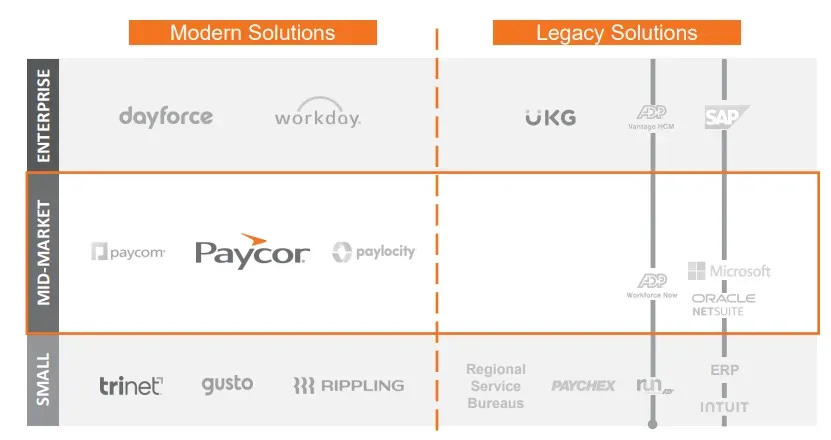A tour through HR and payroll processing software: part 2 (Rippling, Deel, UKG)
Folks, a few announcements:
First, I’m creating short 5-7 minute AI-generated podcast conversations based on my write-ups using NotebookLM and making them freely available on the scuttleblurb podcast feed (Apple, Spotify). These are not meant to be replacements for the actual write-ups and, to be honest, they aren’t even perfectly accurate summaries of them. I’ve noticed a few hallucinations here and there. But they are good enough to serve as teasers - a quick way for you to gauge whether the 5,000 to 10,000-word write-up is worth your time. This may suck, but let’s see how it goes.
Second, MBI and I discussed Airbnb and Booking in the most recent episode of Never Sell (Spotify, Apple, YouTube, RSS Feed)
Related posts:
A tour through HR and payroll processing software: part 1 (Paycor, PAYC, PCTY)
In part 1 of this series, I described how payroll processing evolved from a manual back-end task outsourced to service bureaus in the 1950s to a digitized cloud-delivered process that was eventually bundled with strategic HR functions, like recruiting the right people and keeping them productive and happy. The idea of a unified, web-hosted payroll and HR suite was first shaped into being in the ‘90s by online payroll processors Paycor, Paycom, and Paylocity, who initially targeted small businesses, then gradually climbed upmarket. Today, their client bases are concentrated in the apricot colored slice below (8,900 US firms with between 50 and 499 employees):
Source: 2024 Paycor Investor Day (11/21/24)
The enterprise layer – comprised of clients with more than 2,500 employees – is dominated by a handful of firms: Dayforce (formerly Ceridian), Workday, UKG (created through the merger of Ultimate Software and Kronos), and ADP, as well as ERP vendors SAP and Oracle. The lowest end of the market – made up of clients with fewer than 50 employees – is served by a variety of regional payroll bureaus and SaaS providers.
The below exhibit from Paycor’s 2024 Analyst Day, divides the landscape by client size and modern vs. legacy solution:
Every vendor on the right half would no doubt bristle at being cast off as “legacy,”; some would contend that their products are as relevant to mid-market employers as to small ones, to enterprise clients as to mid-market ones. Still, in terms of both market perception and revenue concentration, the diagram offers a reasonably accurate snapshot of where each firm falls within the broader HCM landscape.
The low end of the market (< 50 employees) is saturated with SaaS point solutions. Many focus on areas like performance reviews, applicant tracking, or learning management, where a small team of engineers can build a polished, feature-rich MVP that shines on design and usability. But payroll is a different beast. It's not a UX problem as much as it is a compliance one. Clients might overlook occasional bugs in an employee survey app, but they won’t tolerate a payroll engine that produces inaccurate paychecks.
The complexity inherent in staying compliant with tax codes and labor laws across thousands of US jurisdictions limits the field of HCM suites with native payroll tax engines to a handful of notable players, who then use payroll as a wedge to win adjacent products like time tracking (scheduling, PTO, sick leave), onboarding, performance reviews, and benefits administration. Most payroll software vendors actually white label their tax calc engine from Symmetry or Vertex, and outsource the filing of tax forms and payments to ADP Mastertax. Within the broader spectrum of payroll complexity, providers serving the low end of the market contend with relatively simple use cases. They can handle standard hourly and salaried compensation for a few dozen employees across a handful of locations with ease, but tend to falter in more complex scenarios, like rolling per-task commissions into the base hourly rate used for overtime calculations, or supporting a dispersed franchise network with teams spread across multiple states.
But that's good enough for your typical Main Street micro business in Anytown, USA that is accustomed to managing things in spreadsheets. They tend to place a premium on usability and product breadth. Gusto (formerly ZenPayroll), with $500mn of revenue in fy23 and a $9.5bn valuation at the time of its May 2022 funding round, is the most prominent of the SaaS HCMs to differentiate this way (its customer base grew from 300k to 400k in the past year, suggesting revenue today is likely well above the last reported $500mn). In recent years, it began taking control of certain back-end functions it had long outsourced, acquiring Symmetry, the payroll tax calculation engine it had relied on since 2012, and developing its own version of MasterTax. With those foundational pieces in place, it then launched a white-label payroll solution, offering embedded payroll capabilities to other software platforms. But for the small businesses that Gusto predominantly caters to, what matters most beyond the table stakes of an accurate tax engine are fast setup times, intuitive user experiences, and tightly integrated payroll-adjacent products like onboarding, time tracking, and benefits administration.
While Gusto sees the SMB market as its final destination, Rippling treats it as a pitstop to much grander terrain. Parker Conrad, previously co-founder and CEO of Zenefits, had an expansive, enterprise-grade vision in mind when he founded Rippling in 2016 and conceived a design architecture that could scale to that future state. Rather than shine on usability, as is the norm for SMB SaaS, Rippling staked its value prop on less visible abstractions that could support the development of a broad constellation of products. At the heart of this approach is a “hub” team dedicated to building and maintaining shared primitives1 – an employee graph that specifies departmental assignments and role changes; org charts that model reporting hierarchies; permission systems that govern access rights; workflow logic that route notifications to the right people – that can be reused across autonomous teams.


